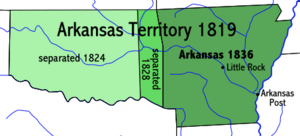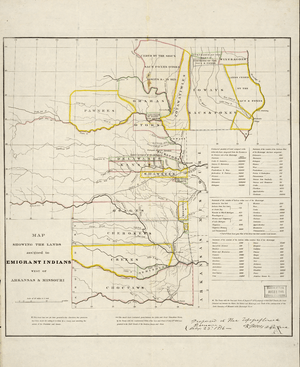Lovely's Purchase facts for kids

Lovely's Purchase was a large area of land in the early 1800s. It was located in what is now Oklahoma and Arkansas. This land was set aside in 1817. It was meant to be a safe home for Cherokee and other Native American groups. These groups were moving west from the southeastern United States. They often faced problems with white settlers and other tribes like the Osage. After many agreements and disagreements, Lovely's Purchase was divided. Most of it went to the Cherokee Nation.
Contents
Why Lovely's Purchase Was Needed
President James Monroe wanted to create a special area for the Cherokee. He called it a "gateway to the setting sun." This land was meant to be a place where the Cherokee could live without being surrounded by white settlers.
Starting in 1809, many Cherokee people began moving west. They came from states like Tennessee, Georgia, Alabama, and the Carolinas. The United States government had promised them new land in Indian Territory. This was for those who traded their eastern homes for land in the west.
The government planned a route for these Cherokee. The goal was to protect them from problems. They wanted to keep them safe from unfriendly American settlers and other Native American groups. These other groups, like the Osage and Quapaw, already lived and hunted on some of these lands. They saw the arriving Cherokee as rivals.
The Osage Nation had given up their hunting rights to this area in 1808. This was part of the Treaty of Fort Clark. However, they still owned the land itself. They also had several villages there. When the new Cherokee migrants arrived, conflicts quickly started. Both Native Americans and white settlers had moved onto the land. The Osage and other tribes especially disliked the Cherokee. They felt the Cherokee were taking their lands and way of life.
Fighting continued between these groups. It became very bad in 1817 after Major Lovely died. But when a strong Cherokee leader named John Jolly arrived in 1818, the fights happened less often.
How Lovely's Purchase Came to Be
Major William Lovely's Role
Major William Lovely was an assistant agent for Native Americans. He worked with the Cherokee in Tennessee. In 1813, he became the main agent for the Arkansas area of the Missouri Territory. His job was to stop the fighting on the frontier. He held this job until 1817. His wife, Persis, joined him in an old Osage village.
Major Lovely was a veteran of the American Revolutionary War. He tried many times to make peace between the Osage and the Cherokee. These tribes were fighting in Indian Territory. His final idea was to create a large strip of land. This land would act as a buffer zone between the two groups.
Lovely's Purchase was created in the early Arkansaw District. It was meant to keep the Cherokee and Osage Nations apart. Lovely bought the first part of the land from the Osage Nation on July 9, 1813.
Another meeting was held in 1816 at the Verdigris River. Lovely agreed to buy millions more acres of Osage hunting land. This land was between the Verdigris and White Rivers. It was bought on behalf of the Cherokee. In total, the land from the Osage was over 7 million acres. This meant the entire northwest corner of the Arkansas Territory now belonged to the Cherokee. Both the Osage and Cherokee promised to follow the 1816 treaty. However, the United States government did not officially approve it. Even with this treaty, the violence between the groups did not stop.

Military Steps and New Forts
The buffer area did not work as planned. So, in 1817, the U.S. Army built Fort Smith. The government also made it clear that Lovely's Purchase would only be for Native Americans. In 1818, another treaty was signed in St. Louis. This treaty between the Osage and Cherokee finally made Lovely's Purchase official. This time, the U.S. government approved it.
In 1819, Arkansas became a separate organized territory from the Missouri Territory. Lovely's Purchase became part of Crawford County at that time. In 1822, Governor James Miller asked for another military outpost. The U.S. government agreed and established Fort Gibson. It was finished in 1824 and guarded by the U.S. Seventh Infantry. Later, lawmakers called this large area "Lovely's Donations."
The area remained a place of conflict. White settlers were constantly being moved out of the expanding Lovely Purchase. The Cherokee were also pressured to leave their rich farmlands and salt mines. These lands were wanted by American frontiersmen.
Lovely County's Brief Existence
A sutler (a person who sells goods to an army) named John Nicks went with the Seventh Infantry to Fort Gibson. He eventually settled near the fort. In 1828, he founded Nicksville. This town became the future capital of Lovely County. More than ten years after Major Lovely's death in 1817, the Arkansas Territory created Lovely County. This county included Lovely's Purchase and other lands.
The Arkansas legislature created Lovely County in 1827. They did this without federal approval. They wanted to keep the area as part of the planned State of Arkansas. Americans immediately started settling there. Lovely County only existed for a short time, from October 31, 1827, to May 6, 1828.
On May 6, 1828, the federal government signed The U.S.–Cherokee Treaty of Washington. This new treaty changed things. The western half of Lovely's Purchase became part of Indian Territory. This land was given completely to the Cherokee Nation—West of the Mississippi. The Osage were moved to the Kansas area. This was done to finally end the fighting. The eastern part of Lovely's Purchase stayed with Arkansas and the American settlers.
To make the agreement happen faster, displaced Native Americans received help. They were given "a good rifle, a blanket, a kettle, and 5 lbs. of tobacco" if they agreed to move. White settlers who were displaced also received help. They were given "320 acres of public domain land in Arkansas Territory" for every head of household over 21 years old.

